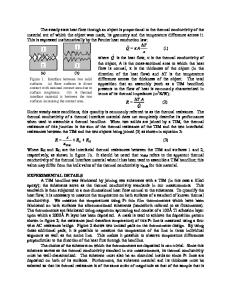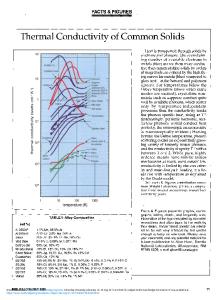Phonons and Thermal Conductivity in Skutterudite Thermoelectrics
- PDF / 97,912 Bytes
- 6 Pages / 612 x 792 pts (letter) Page_size
- 105 Downloads / 393 Views
S4.4.1
Phonons and Thermal Conductivity in Skutterudite Thermoelectrics C. A. Kendziora1 and G. S. Nolas2, 1 Materials Science and Technology Division, Naval Research Laboratory, Washington, DC 20375 2 Department of Physics, University of South Florida, Tampa, FL 33620 ABSTRACT We study Raman phonon vibrations and relate them to thermal conductivity for empty and filled skutterudites designed for thermoelectric applications, where low thermal conduction is critical. Polarized Raman scattering spectra of crystallite and polycrystalline samples are compared with theoretical predictions and analyzed in comparison to the thermal conduction properties. Our emphasis is on the CoSb3 skutterudite and its filled derivatives, including materials with Ge, Sn, and La in the cages. We observe a strong correlation between aspects of the Raman spectrum and low thermal conductivity. This presents Raman spectroscopy as a characteristic screening tool for potential thermoelectrics and is a crucial step toward predicting lattice thermal conductivities. INTRODUCTION Thermoelectric devices have applications for both cooling to low temperatures and power generation at high temperatures. In both cases, the utility of a material can by summarized by a single dimensionless “figure of merit”, defined to be ZT=S2σ/κ, where T is temperature (K), S is the Seebeck coefficient, σ is the electronic conductivity, and κ is the thermal conductivity. Perhaps the most common route to material optimization is the reduction of thermal conductivity. A low thermal conductivity allows the device to maintain the large thermal gradient crucial for most applications. Thermal conductivity is generally limited by the lattice component κL. The paradigm for reducing this is due to Slack 1, who proposed that “rattling” vibrations of a large atom weakly bound within a “cage” structure would frustrate thermal transport. The skutterudite structure contains such a void and has been explored by a variety of techniques for thermoelectric applications.2,3 In this manuscript, we discuss the Raman scattering spectra of CoSb3 skutterudite and its filled derivatives. The goal of this research is to understand the lattice dynamics of the material in order to correlate with the lattice thermal conductivity. In particular, the frequencies of eigenmodes of the lattice are a crucial parameter in modeling the thermal conductivity.4,5 EXPERIMENTAL DETAILS The skutterudite materials examined here have been prepared by direct synthesis of the elements 3 and by a high-pressure technique 6. The pure CoSb3 specimens were melt-grown from an Sb flux at ambient pressure and annealed. They consisted of relatively large crystallites, with grains of the order of 1 mm. High-pressure synthesis fomented the inclusion of Ge and Sn into the voids and resulted in dense polycrystalline material. All samples were cut and polished. Polarized Raman measurements were made in a near-backscattering geometry to reduce the Rayleigh scattered light collected. By utilizing a high-resolution Dilor 500 mm tripl
Data Loading...










